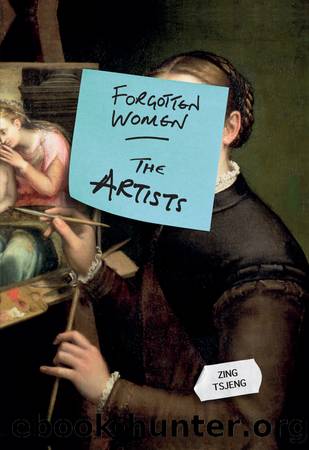Forgotten Women : The Artists (9781788401142) by Tsjeng Zing

Author:Tsjeng, Zing
Language: eng
Format: epub
Publisher: Hachette Book Group USA
Published: 2018-08-16T00:00:00+00:00
WEI SHUO
n China, the expression wenfang sibao is used to refer to a quartet of specific objects: brush, ink, paper and inkstone. Its translation? The four treasures of the study. As a civilization that prizes calligraphy â not painting or sculpture â as its greatest visual art, there could be no other way to describe its tools. And nobody was more devoted to it than Wei Shuo (AD 272â 349), more commonly known as Lady Wei â Chinaâs earliest-recorded female calligrapher and one of the pioneers of the art form.
Born during the Jin dynasty in present-day Shanxi, Wei Shuo belonged to an illustrious family of calligraphers and scholars. Her uncle and cousin were both well-respected calligraphers who had mastered the many different schools of the art; Wei Hang, her cousin, had written a book, entitled Si ti shu shi (âThe Trend Toward Four Styles of Calligraphyâ), which later landed him a mention in the official History of the Jin Dynasty.
In ancient China, oneâs deftness with a brush indicated more than just expertise â it was considered a powerful expression of your innermost thoughts and spirit. Later on, in the Qing dynasty (1644â1912), the scholar Liu Xizai believed that it could communicate everything from the artistâs own private ambitions to their intellect and learning. But this was an art form that was dominated by men; few women were expected to learn to put brush to paper.
For Wei Shuo, however, calligraphy held the promise of creation itself. âA horizontal line has the momentum of clouds stretching in an unbroken chain for thousands of miles; a dot, a stone falling from a lofty peak; a vertical stroke, a withered vine thousands of years old; a hooked dot, hundreds of arrows shot at one time,â23 she once said. With just a few well-formed characters, an especially skilful calligrapher like Wei Shuo could sketch nothing less than the entire world.
It is said that she displayed an interest in calligraphy even as a young girl, when she was permitted to observe the men in her family at work. On a good day, she might be graciously allowed to grind ink for their inkstone. Once she was alone, Wei Shuo would practise the brushstrokes from memory, and it was only after her uncle accidentally saw her work that she was finally allowed to learn calligraphy.
None of her work has survived, but her artistic legacy lives on. Just like her cousin, Wei Shuo wrote a celebrated treatise that established some of the foundational rules of calligraphy and dramatically influenced its aesthetic philosophy. Bizhen tu (âIllustrated Formation of the Writing Brushâ) is no obscure philosophical tract either. Think of it as Wei Shuoâs battle cry for the art form, as this extract from it illustrates:
Paper is battle ground. Brush is sword and shield; ink is armor; inkstone is a city wall and a moat; the heartâs intent is the general; technical skills are lower-ranking generals; and structure is the strategy. Lifting the brush heralds life or death; moving the
Download
This site does not store any files on its server. We only index and link to content provided by other sites. Please contact the content providers to delete copyright contents if any and email us, we'll remove relevant links or contents immediately.
The Japanese by Christopher Harding(1109)
Watercolor With Me in the Forest by Dana Fox(768)
A Theory of Narrative Drawing by Simon Grennan(757)
Glittering Images: A Journey Through Art From Egypt to Star Wars by Camille Paglia(754)
The Story of the Scrolls by The Story of the Scrolls; the M(745)
Boris Johnson by Tom Bower(634)
This Is Modern Art by Kevin Coval(615)
Frida Kahlo by Frida Kahlo & Hayden Herrera(603)
The Art and Science of Drawing by Brent Eviston(602)
AP Art History by John B. Nici(594)
Banksy by Will Ellsworth-Jones(580)
About Looking by John Berger(571)
Scenes From a Revolution by Mark Harris(566)
Van Gogh by Gregory White Smith(563)
War Paint by Woodhead Lindy(560)
Draw More Furries by Jared Hodges(556)
Ecstasy by Eisner.;(552)
100 Greatest Country Artists by Hal Leonard Corp(531)
Young Rembrandt: A Biography by Onno Blom(528)
